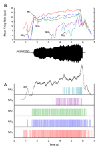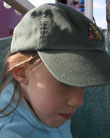Ruth went through four major cycles of diagnostic testing between delivery and her diagnosis of Congenital Myasthena Gravis [CMG] via an Electromyograph [EMG] on August 2, 2005.
The table below lists Ruth's results among the standard methods of diagnosis for neuromuscular diseases.
Disclaimer: The unedited source of the table below is found on MDA's Web Site (middle of page).
| Type | Test | What It Shows | Ruth's Results 1995 | Ruth's Results 2001 | Ruth's Results 2002 | Ruth's Results 2005 |
|---|---|---|---|---|---|---|
Blood Enzyme Test |
1. Lactate and pyruvate levels | 1. If elevated, may indicate deficiency in respiratory chain; abnormal ratios of the two may help identify the part of the respiratory chain that is blocked. | 1. Unknown if test performed. | 1. Normal. | 1. N/A | 1. N/A |
| 2. Serum creatine kinase | 2. May be slightly elevated in mitochondrial disease but usually only high in cases of mitochondrial DNA depletion. | 2. Unknown if test performed. | 2. Normal. | 2. N/A | 2. N/A | |
Muscle Biopsy |
1. Histochemistry | 1. Detects abnormal proliferation of mitochondria and deficiencies in cytochrome C oxidase (COX) activity. | 1. Normal Tissue, very low COX enzymes (suspect diagnosis). | 1. Normal. | 1. N/A | 1. N/A |
| 2. Immuno-histochemistry | 2. Detects presence or absence of specific proteins -- can rule out other diseases or confirm loss of respiratory chain proteins. | 2. Test inconclusive. | 2. Normal. | 2. N/A | 2. N/A | |
| 3. Electron microscopy | 3. May confirm abnormal appearance of mitochondria. Not used much today. | 3. Unknown if test performed. | 3. Normal muscle structure, but abnormally high ratio of Type 1 ("slow-twitch") muscle fibers. | 3. N/A | 3. N/A | |
| 4. Biochemistry | 4. Measures activities of specific respiratory chain enzymes. A special test called polarography measures oxygen consumption in mitochondria. | 4. Very low COX enzymes (suspect diagnosis). | 4. Normal COX enzymes, addt'l results pending. | 4. N/A | 4. N/A | |
Molecular Test |
1. Known mutations | 1. Uses blood sample or muscle sample to screen for known mutations, looking for common mutations first. | 1. No known mutations. | 1. No known mutations. | 1. N/A | 1. N/A |
| 2. Rare or unknown mutations | 2. Can also look for rare or unknown mutations but may require samples from family members; this is more expensive and time-consuming. | 2. Tests for unknown mutations not performed. | 2. Results pending for FSH Dystrophy. | 2. Negative for FSH Dystrophy | 2. N/A | |
Electromyography |
Surface and/or needle stimulation of muscle using pulses of electricity. | Used to diagnose disorders of the neuromuscular junction. Disorders that weaken the nerve's connection to a muscle will produce abnormal electrical activity in muscles (Myasthenias produce decrements) | Inconclusive, with Tensilon. | N/A | N/A | Indications for Congenital Myasthenia Gravis, with Tensilon. |
